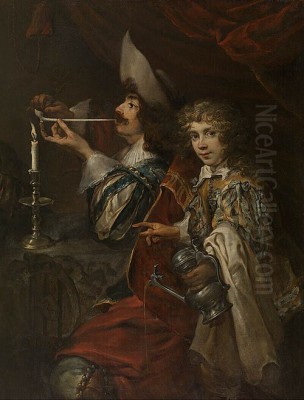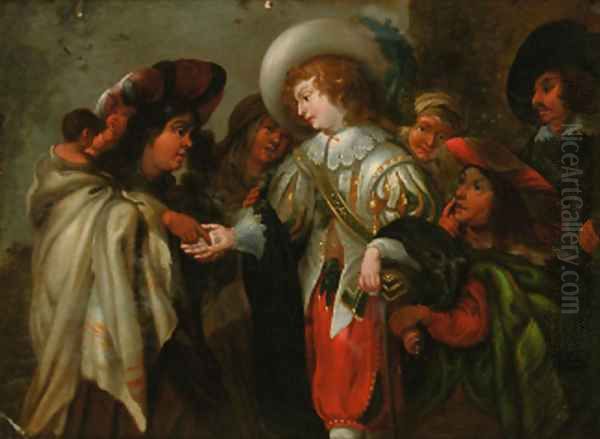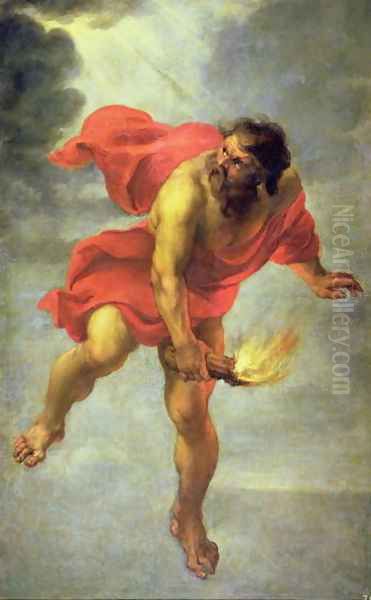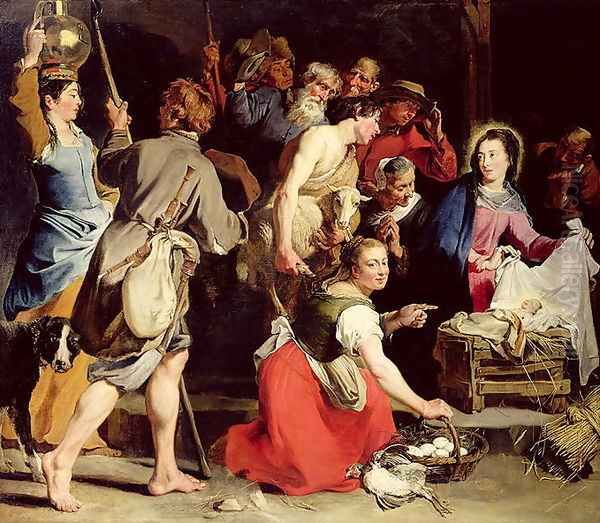
Jan Cossiers stands as a significant figure in the rich tapestry of 17th-century Flemish art. Born in Antwerp, the vibrant artistic hub of the Southern Netherlands, Cossiers navigated the dynamic currents of the Baroque era, leaving behind a legacy marked by powerful compositions, dramatic lighting, and insightful portraiture. His life and career reflect the artistic shifts of his time, most notably the pervasive influence of Caravaggio and the towering presence of Peter Paul Rubens.
Early Life and Artistic Formation
Jan Cossiers entered the world in Antwerp on July 15, 1600. Artistry was in his blood; his father, Anton Cossiers, was also a painter, providing Jan's initial exposure to the craft. Following this familial introduction, the young Cossiers further honed his skills under the tutelage of Cornelis de Vos, a prominent Antwerp painter known for his portraits and historical scenes. This apprenticeship provided a solid foundation in the techniques and traditions prevalent in the city's competitive artistic environment.
De Vos himself was a successful artist, known for his sensitive portraiture and large-scale history paintings. Training within such a respected workshop would have equipped Cossiers with the technical proficiency and professional connections necessary to launch his own career. The Antwerp artistic scene was dominated by the Guild of Saint Luke, the professional organization for painters and other artisans, which set standards and regulated the trade. Aspiring artists typically underwent rigorous training before being accepted as masters.
Travels and the Influence of Caravaggism
Seeking broader horizons and deeper artistic knowledge, Cossiers embarked on travels southward around 1623. His journey took him first to Aix-en-Provence in France. During his time there, he reportedly studied or associated with the painter Abraham van de Veld, further expanding his artistic vocabulary. This period abroad was crucial for many Northern European artists, offering exposure to different styles and classical antiquity.

The most transformative part of his journey was his visit to Rome, likely beginning in 1624. The Eternal City was a crucible of artistic innovation, and Cossiers, like many contemporaries, was profoundly struck by the works of Michelangelo Merisi da Caravaggio. Caravaggio's revolutionary use of chiaroscuro – dramatic contrasts between light and shadow – and his realistic, often gritty, portrayal of religious and genre subjects left an indelible mark on Cossiers' early development.
Returning to Antwerp by 1626, Cossiers brought with him the stylistic lessons learned in Italy. His early works from this period often reflect a strong Caravaggesque influence. He focused on genre scenes, frequently depicting low-life subjects, musicians, gamblers, and fortune tellers, rendered with the characteristic tenebrism and dramatic intensity inspired by Caravaggio and his followers, known as the Caravaggisti.
A prime example of this phase is The Fortune Teller. This painting typically showcases Cossiers' early mastery of chiaroscuro, focusing light on the central figures while plunging the background into shadow. The subject matter – interactions between seemingly ordinary people, often with an undercurrent of psychological tension or moral ambiguity – aligns perfectly with the themes popularized by Caravaggio. The realism in depicting expressions and textures also points to the Italian master's influence.
Establishing a Career in Antwerp
Back in his native city, Cossiers quickly established himself. He was officially registered as a master in the Antwerp Guild of Saint Luke in the guild year 1628–1629. This recognition marked his formal entry into the professional ranks of Antwerp painters, allowing him to establish his own workshop, take on apprentices, and accept commissions independently.
During his travels, Cossiers had also forged important connections. He came into contact with Nicolas-Claude Fabri de Peiresc, a renowned French scholar and patron of the arts whose network spanned across Europe. Such connections were invaluable. Furthermore, Cossiers gained the attention and likely the support of Peter Paul Rubens, the undisputed giant of Flemish Baroque painting.
Rubens' influence and possible recommendation opened significant doors for Cossiers. It is suggested that through Rubens, Cossiers began receiving prestigious commissions, potentially including work for high-ranking officials and even European royalty, such as the Spanish court. Being associated with Rubens' circle was a significant advantage in Antwerp's bustling art market.
Collaboration with and Influence of Rubens
The relationship with Peter Paul Rubens became a defining aspect of Cossiers' career, particularly from the 1630s onwards. While Cossiers initially made his mark with Caravaggesque genre scenes, his style evolved under the influence of Rubens' dynamic compositions, vibrant palette, and grand narrative approach. He became a frequent collaborator in Rubens' large workshop, contributing to major projects.

One of the most significant collaborations was for the decoration of the Torre de la Parada, Philip IV of Spain's hunting lodge near Madrid, around 1636-1638. Rubens oversaw this massive commission, designing numerous mythological scenes based on Ovid's Metamorphoses, which were then executed by various Antwerp painters, including Cossiers.
Cossiers painted several canvases for the Torre de la Parada based on Rubens' oil sketches. Among these is Prometheus Carrying Fire. For a long time, the precise authorship of some Torre de la Parada paintings was debated, but the discovery of Cossiers' signature on the Prometheus canvas in the Prado Museum confirmed his significant contribution to this royal commission. This project showcased his ability to adapt to Rubens' grand manner while retaining his own touch.
The influence of Rubens is also evident in Cossiers' shift towards history painting and large-scale religious works. His palette brightened, his compositions became more complex and dynamic, and his figures often took on the more idealized, robust quality characteristic of Rubens' style. Works like The Supper at Emmaus demonstrate this evolution, combining dramatic lighting reminiscent of his earlier phase with warmer colors and emotionally charged figures typical of the Rubenesque approach.
Mature Style: History, Religion, and Portraiture
In his mature phase, Jan Cossiers emerged as one of Antwerp's leading painters, particularly adept at history painting, religious subjects, and portraiture. Following Rubens' death in 1640, Cossiers, alongside contemporaries like Jacob Jordaens and Gaspar de Crayer, helped fill the void, becoming one of the primary providers of large altarpieces and religious narratives for churches and religious institutions in the Southern Netherlands.
His religious paintings often display intense piety and emotional depth, rendered with a sophisticated handling of light and color. Works such as The Adoration of the Shepherds (dated 1657 in one version) exemplify his ability to infuse traditional religious scenes with palpable humanity and atmospheric effects. He received numerous commissions from churches in Antwerp, Mechelen, and other Flemish towns, solidifying his reputation as a master of sacred art.
Cossiers was also a highly accomplished portrait painter. He captured the likenesses of fellow artists, members of the bourgeoisie, and family members with remarkable sensitivity. His portraits are noted for their psychological insight, moving beyond mere physical representation to convey the sitter's character and inner state. His skill in rendering textures – the richness of fabrics, the softness of skin – added to the lifelike quality of his portraits.

Among his most admired works in this genre are the portraits of his own family, particularly those of his sons. These intimate portrayals are often praised for their tenderness and masterful handling of light, showcasing a more personal side of the artist's output. They stand as testament to his versatility and his ability to excel across different genres. His reputation as a colorist, noted by contemporaries, is evident in the subtle harmonies and rich tones found throughout his oeuvre.
Collaborations and Artistic Milieu
The Antwerp art scene in the 17th century was characterized by extensive collaboration between artists specializing in different areas. Jan Cossiers participated actively in this practice. While he was fully capable of executing figures, he sometimes collaborated with artists who specialized in still life or animals to complete compositions.
Records and stylistic analysis suggest collaborations with still life and animal painters such as Frans Snyders, Jan Fyt, and Pieter Boel. In such works, Cossiers would typically paint the figures, while the specialist would add elements like fruit, game, or background details. This division of labor allowed for efficient production and combined the strengths of different masters, resulting in high-quality, elaborate paintings popular with collectors.
Cossiers operated within a vibrant community of artists. Besides his teacher Cornelis de Vos and the dominant figure of Rubens, his contemporaries included major talents like Anthony van Dyck (though Van Dyck spent much of his career abroad), Jacob Jordaens, Jan Boeckhorst, Simon de Vos, and Jan Lievens. He also interacted with genre painters like Adriaen Brouwer. An interesting anecdote relates to Brouwer's famous painting The Smokers, where one of the figures depicted in the rowdy tavern scene is believed by some art historians to be a portrait of Jan Cossiers himself, suggesting camaraderie among Antwerp's artists.
His standing within this community was high. He served as the dean of the Antwerp Guild of Saint Luke on multiple occasions, a position of considerable responsibility and prestige, reflecting the respect he commanded among his peers. This role involved overseeing the guild's affairs, upholding standards, and representing the interests of its members.
Later Career and Legacy
In the decades following Rubens' death in 1640, Jan Cossiers' prominence grew. He became one of the most sought-after painters in Flanders for large-scale commissions, particularly altarpieces and historical cycles. His workshop remained productive, training pupils and fulfilling demands from both ecclesiastical and private patrons. His style continued to balance the dramatic flair of the Baroque with a sense of classical dignity.
His later works maintained a high level of quality, characterized by competent draughtsmanship, balanced compositions, and a refined, often more subdued, color palette compared to the high-key colors sometimes employed under Rubens' direct influence. He remained a respected figure in Antwerp's cultural life until his death.
Jan Cossiers passed away in Antwerp on July 4, 1671, just shy of his 71st birthday. He left behind a substantial body of work that reflects the major artistic currents of his time while showcasing his individual talent. His paintings are housed today in major museums across the world, including the Louvre Museum in Paris, the Prado Museum in Madrid, the Royal Museums of Fine Arts of Belgium in Brussels, the Hermitage Museum in Saint Petersburg, and numerous other public and private collections.
Art Historical Assessment
Academic evaluation places Jan Cossiers firmly among the most important Flemish painters of the 17th century. While perhaps overshadowed internationally by the fame of Rubens, Van Dyck, and Jordaens, he was a leading master in his own right, particularly influential in the Antwerp school during the mid-century. His initial adoption and skillful adaptation of Caravaggism made him a key figure in introducing and popularizing this style in Flanders.
His subsequent absorption of Rubens' style demonstrates his versatility and ability to engage with the dominant artistic force of his era. The synthesis he achieved between the dramatic realism of Caravaggio and the dynamic grandeur of Rubens resulted in a powerful and often emotionally resonant style. He is particularly praised for his skills as a draughtsman, his effective compositions, and his sensitive handling of color and light.
His contributions to religious art in the post-Rubens era were crucial for maintaining the vitality of the Flemish tradition in this genre. His portraits are recognized for their psychological depth and technical refinement. While some critics might occasionally find his compositions less fluid or his elegance less effortless than that of Rubens, his overall achievement is widely acknowledged.
Jan Cossiers remains a key figure for understanding the breadth and depth of Flemish Baroque painting. He successfully navigated the stylistic shifts from Caravaggism to the High Baroque, collaborated with the greatest master of his time, and ultimately forged a distinct and respected artistic identity. His work continues to be studied and appreciated for its technical mastery, emotional power, and historical significance as a reflection of Antwerp's golden age of painting.